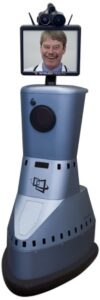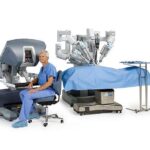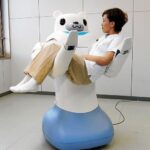Healthcare Robots Sell High-Tech Branding and Benefits
 Our recent post titled, Meet Two Virtual Nurses Now Working in Medical Marketing, attracted a lot of reader interest and feedback. These two examples of technology interacting with patients for patient discharge and infection control are also marketing opportunities on at least two fronts.They do an important job at a cost-saving rate, and they spotlight a hi-tech point of differentiation.
Our recent post titled, Meet Two Virtual Nurses Now Working in Medical Marketing, attracted a lot of reader interest and feedback. These two examples of technology interacting with patients for patient discharge and infection control are also marketing opportunities on at least two fronts.They do an important job at a cost-saving rate, and they spotlight a hi-tech point of differentiation.
Along this same tech highway, here are more examples of “healthcare robotics” and some ways that these or similar devices can be used in hospital or medical practice marketing.
In addition to their intended patient care purpose, they are tangible proof points in support of “high tech,” “leading edge,” “advanced,” or similar positioning and branding messages. And the media loves high-tech-human-interest, so it’s a natural to leverage for community and public relations.
 FAMOUS NAME ROBOT: DaVinci Surgical System -- The highest name recognition factor goes to Intuitive Surgical’s DaVinci system. The manufacturer lists the benefits as reducing hospital stays, lower cost, less pain and speedier recovery.
FAMOUS NAME ROBOT: DaVinci Surgical System -- The highest name recognition factor goes to Intuitive Surgical’s DaVinci system. The manufacturer lists the benefits as reducing hospital stays, lower cost, less pain and speedier recovery.
HUGGABLE SOFT ROBOT: RIBA – Robot for Interactive Body Assistance – Think of RIBA as a cuddly-soft urethane foam forklift. Chances are you don’t have one yet since they are newly tested in Japanese nursing homes. They lift people who are too weak to sit, walk or stand by themselves.

REMOTE PRESENCE ROBOT (IN NEED OF A FRIENDLIER NAME): InTouch Health RP-7 – This robot—the flagship product of InTouch—removes time and distance barriers, bringing the practitioner to the remotely located patient. In addition to eyes and ears, RP-7 has the capability to plug-in a stethoscope, ultrasound and transmit medical data to the remote physician.
These and similar medical marvels are fascinating to the public, and are deserving of showcasing on a website, via YouTube, in community health fairs and other healthcare PR venues. A media interview with a robot, such as RP-7, would have a lot of editor appeal. (Maybe give it a white coat and a friendly name for wider audience appeal.)
A note of caution: Healthcare delivery is heavily vested in caring and person-to-person relationships and can, if not presented properly, can clash head-on with seemingly impersonal “robotics.”
What’s more, some demographic groups are not easily trusting of “high tech” advances. Healthcare marketing efforts need to be sensitive to these issues, present them in the context of clear and direct patient benefits, and—to the extent possible—demonstrate how they are user- and patient-friendly.
What technology and medical advances do you have for an appealing show-and-tell? How have you been able to demonstrate value and benefit for prospective patients? We’d like to hear from you.









